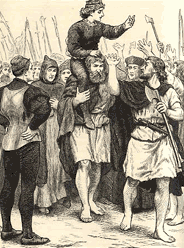Nicholas St Lawrence, 4th Baron Howth
Nicholas St Lawrence, 4th Baron Howth (c. 1460 – 1526) was a leading Irish soldier and statesman of the early Tudor period.
Early life
He was born about 1460, eldest son of Robert St Lawrence, 3rd Baron Howth and his first wife Alice White. His stepmother Joan Beaufort was a cousin of Henry VII, to whom Nicholas, unlike most of his peers, remained entirely loyal. The date of his father's death and his own succession to the title is in dispute but it was probably no later than 1487.
Lambert Simnel
The pretender Lambert Simnel appeared in Ireland claiming to be Edward, Earl of Warwick, nephew of Edward IV. Simnel gained the support of most of the Anglo-Irish nobility, notably the powerful 8th Earl of Kildare, and was crowned as "King Edward VI" at Christ Church Cathedral in Dublin 1487. Nicholas, however, no doubt mindful of his own close connection to the Tudor dynasty, warned Henry VII of the impending invasion. Following Henry's triumph at the Battle of Stoke, Nicholas was rewarded with a substantial grant of money and confirmation of his right to Howth.
The King, however, could not resist playing a joke by inviting Howth, with ten other Irish nobles, to a banquet at Greenwich in 1489 where, to their great embarrassment, they were waited on at table by Lambert Simnel, who had been pardoned and made a kitchen boy; (he was later promoted to the office of Falconer).

Battle of Knockdoe
Despite their differences over the Simnel rebellion, Howth became a close ally of Kildare (who like Simnel had received a pardon from Henry VII), and he later challenged Thomas Butler, 7th Earl of Ormond to a duel on Kildare's account. He also quarreled with Sir James Butler, Ormonde's cousin, who predicted, wrongly, that Nicholas' stout and bullish nature would see him die by violence.[1] Kildare and Howth fought together at the bloody Battle of Knockdoe in 1504 between the forces of the Crown and the Burkes of Connaught.[2] Howth is credited with urging the immediate attack which resulted in a victory for the Crown's forces.
Lord Chancellor of Ireland
Lord Howth was Lord Chancellor of Ireland from 1509 to 1513. O'Flanagan remarks that his entire training was as a soldier and that the appointment was presumably a tribute to his loyalty to the Crown, rather than due to any legal ability; on the other hand his uncle and brother were both distinguished lawyers.[3] O'Flanagan also notes that his career as Chancellor leaves no trace on the records but that in the absence of any known complaints about his performance, he presumably fulfilled his duties adequately enough.[4] The death of his great patron, the Earl of Kildare in 1513 meant the end of Howth's political career; he was dismissed from the Chancellorship and the Council and lived in retirement until his death in 1526.
Family
Lord Howth married three times and had children by each marriage. His first wife was Genet, daughter of Christopher Plunket, 3rd Baron Killeen, by his wife Elizabeth Welles, daughter of Sir William Welles, Lord Chancellor of Ireland; his second wife was Anne, daughter of Thomas Berford; and his third wife, who outlived him, was Alison Fitzsimon, sister of Walter Fitzsimon, Archbishop of Dublin, and widow of Sir Nicholas Cheevers. After Lord Howth's death, death Alison made a third marriage into the Plunkett family.[5] He had eleven children, although it is not entirely clear which child was by which marriage:
- Christopher St Lawrence, 5th Baron Howth;
- Amory;
- Robert;
- Thomas;
- Katherine, who married Sir John Plunkett;
- Marian, who married firstly Sir Christopher Nugent, by whom she was the mother of the 5th Baron Delvin; she married secondly Sir Gerald Fitzgerald, Knight Marshal of Ireland, and thirdly John Parker, the Master of the Rolls in Ireland;
- Eleanor, who married Sir Walter Cheevers, (who was her stepmother Alison's son by a previous marriage);
- Margaret, who married Sir William Darcy;
- Elizabeth, who married Thomas Netterville, judge of the Court of Common Pleas (Ireland);
- Alison, who married firstly John Netterville of Dowth, ancestor of the 1st Viscount Netterville and secondly Sir Patrick White, Baron of the Court of Exchequer (Ireland);
- Anne, who married Thomas Cusack.
References
- ↑ Ball, F. Elrington History of the Parishes of Dublin Vol.5 Dublin 1917
- ↑ O'Flanagan, J. Roderick Lives of the Lord Chancellors and Keepers of the Great Seal of Ireland 2 Volumes London 1870
- ↑ Ball F. Elrington, The Judges in Ireland 1221-1921 (1926). John Murray, London.
- ↑ Lives of the Lord Chancellors
- ↑ Cokayne Complete Peerage